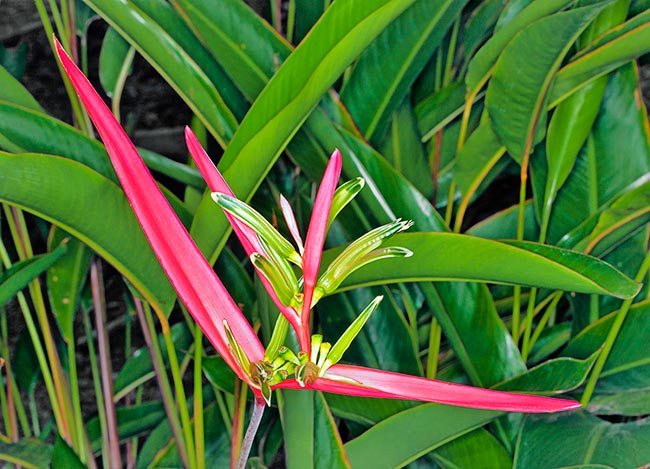Family : Heliconiaceae

Text © Pietro Puccio

English translation by Mario Beltramini
Excellent for edges, Heliconia acuminata flowers the whole year in the tropics © Giuseppe Mazza
The name of the genus comes from the Latin “Heliconius, a, um” = of the Helicon, mountain sacred to Apollo and to the other Muses in the Greek mythology; the name of the species is the Latin adjective “acuminatus, a, um” = acuminate, pointed, with reference to the apex of the leaves, abruptly pointed.
Common names: false bird of Paradise, yellow heliconia (English); bico-de-tucano, caetê, tracoá (Portuguese-Brazil); platanilla, sororoquinha (Spanish).
The Heliconia acuminata A. Rich. (1831) is a perennial, evergreen, erect rhizomatous herbaceous species, forming dense 0,6-2 m tall tufts.
The leaves, on a 10-45 cm long petiole, are basal, alternate, simple, entire, oblong-lanceolate with abrupt and long pointed apex, of intense green colour with prominent central nervation of red colour below, 35-60 cm long and 7-16 cm broad, and sheathing foliar bases forming a pseudo-stem.
The inflorescence, on a robust peduncle, is an erect terminal spike 10-22 cm long with red wavy rachis and 3-7 alternate, wide apart and acuminate bracts, distichous, coriaceous, with the concavity bent upwards and arranged almost horizontally, pinkish to red coloured, 8-12 cm long.
The bracts enclose several tubular flowers of yellow colour with a green band towards the apex, 3-4 cm long, opening in succession on an about 2 cm long pedicel; the flowers, hermaphroditic, but self-incompatible, are pollinated by the hummingbirds, mainly by the Phaethornis superciliosus (Linnaeus, 1766) and the Phaethornis bourcieri (Lesson, 1832).
The fruits are globose drupes of about 0,5 cm of diameter, dark blue when ripe, containing 1-3 seeds.

Hermaphrodite, self-incompatible flowers are pollinated by hummingbirds. The fruits are globose drupes © Mazza
It requires a semi-shaded position and soils rich of organic substance, acidic or neutral, draining, kept almost constantly humid, but without stagnations.
Where the climate does not allow the permanence in open air during the winter months, it can be cultivated in pot in order to shelter it in greenhouses, verandas or winter gardens, even if averagely luminous, being less particular from this point of view than other species, utilizing an organic substratum with addition of siliceous sand or perlite for a 30% to improve the drainage, with winter day temperatures of 20-24 °C and lowest night ones not under the 16 °C.
The watering must be regular and abundant in summer, avoiding stagnations, cause of easy rottenness, more spaced in winter, allowing the substratum to partially dry up before giving water again, with fertilizations done preferably with slow release balanced products with addition of microelements.
Synonyms: Bihai acuminata (A.Rich.) Kuntze (1891).
